57 Books Published by New York University Press on AALBC — Book Cover Collage
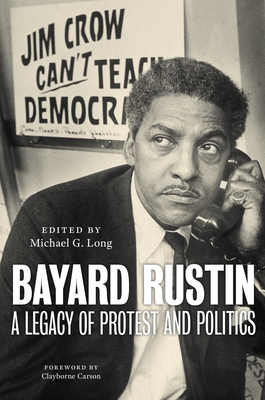 Bayard Rustin: A Legacy of Protest and Politics
Bayard Rustin: A Legacy of Protest and Politics
by Michael G. LongNew York University Press (Sep 26, 2023)
Read Detailed Book Description
This volume celebrates the life and legacy of Bayard Rustin, the often overlooked civil rights leader behind the 1963 March on Washington for Jobs and Freedom. While Martin Luther King Jr.’s "I Have a Dream" speech is etched into the collective memory, fewer people recognize the pivotal role Rustin played in organizing this monumental event in just eight weeks.
Rustin was far more than just an organizer. As a committed pacifist, he introduced the principles of Gandhi’s protest techniques to American civil rights activism. He helped establish the Southern Christian Leadership Conference, fought for economic justice, and was instrumental in shaping Dr. King into an international emblem of nonviolent resistance. His influence extends to numerous aspects of modern life—from nonviolent protest to systemic change, from the workings of democracy to the notions of socialism, and from the evolution of criminal justice to the stance against war.
Despite his monumental achievements, Rustin often found himself sidelined, largely because he was an openly gay man in a period marked by intense homophobia. He faced numerous obstacles, including threats, arrests, physical assaults, imprisonment, and removal from key leadership roles. This volume aims to bring him out from the historical shadows, featuring expansive, probing, and sometimes critical essays from a diverse group of writers—including Walter Naegle, Rustin’s own partner. Together, these essays paint a comprehensive portrait of Bayard Rustin as a gay, pacifist, socialist visionary who not only altered the trajectory of American history but also laid the groundwork for future movements, from LGBTQ+ Pride to Black Lives Matter.
 The Tuskegee Student Uprising: A History
The Tuskegee Student Uprising: A History
by Brian JonesNew York University Press (Oct 04, 2022)
Read Detailed Book Description
The untold story of a dynamic student movement on one of the nation’s most important historically Black campuses
The Tuskegee Institute, one of the nation’s most important historically Black colleges, is primarily known for its World War II pilot training program, a fateful syphilis experiment, and the work of its founder, Booker T. Washington. In The Tuskegee Student Uprising, Brian Jones explores an important yet understudied aspect of the campus’s history: its radical student activism.
Drawing upon years of archival research and interviews with former students, professors, and administrators, Brian Jones provides an in-depth account of one of the most dynamic student movements in United States history. The book takes the reader through Tuskegee students’ process of transformation and intellectual awakening as they stepped off campus to make unique contributions to southern movements for democracy and civil rights in the 1960s. In 1966, when one of their classmates was murdered by a white man in an off-campus incident, Tuskegee students began organizing under the banner of Black Power and fought for sweeping curricular and administrative reforms on campus. In 1968, hundreds of students took the Board of Trustees hostage and presented them with demands to transform Tuskegee Institute into a "Black University." This explosive movement was thwarted by the arrival of the Alabama National Guard and the school’s temporary closure, but the students nevertheless claimed an impressive array of victories. Jones retells these and other events in relation to the broader landscape of social movements in those pivotal years, as well as in connection to the long pattern of dissent and protest within the Tuskegee Institute community, stretching back to the 19th century. A compelling work of scholarship, The Tuskegee Student Uprising is a must-read for anyone interested in student activism and the Black freedom movement.
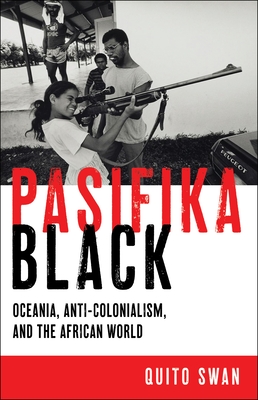 Pasifika Black: Oceania, Anti-Colonialism, and the African World
Pasifika Black: Oceania, Anti-Colonialism, and the African World
by Quito SwanNew York University Press (May 10, 2022)
Read Detailed Book Description
A lively living history of anti-colonialist movements across the Atlantic, Pacific, and Indian Oceans
Oceania is a vast sea of islands, large scale political struggles and immensely significant historical phenomena. Pasifika Black is a compelling history of understudied anti-colonial movements in this region, exploring how indigenous Oceanic activists intentionally forged international connections with the African world in their fights for liberation.
Drawing from research conducted across Fiji, Australia, Vanuatu, Papua New Guinea, Britain, and the United States, Quito Swan shows how liberation struggles in Oceania actively engaged Black internationalism in their diverse battles against colonial rule. Pasifika Black features as its protagonists Oceania’s many playwrights, organizers, religious leaders, scholars, Black Power advocates, musicians, environmental justice activists, feminists, and revolutionaries who carried the banners of Black liberation across the globe. It puts artists like Aboriginal poet Oodgeroo Noonuccal and her 1976 call for a Black Pacific into an extended conversation with Nigeria’s Wole Soyinka, the Nuclear Free and Independent Pacific’s Amelia Rokotuivuna, Samoa’s Albert Wendt, African American anthropologist Angela Gilliam, the NAACP’s Roy Wilkins, West Papua’s Ben Tanggahma, New Caledonia’s D w Gorodey, and Polynesian Panther Will ’Ilolahia. In so doing, Swan displays the links Oceanic activists consciously and painstakingly formed in order to connect Black metropoles across the Atlantic, Pacific, and Indian Oceans.
In a world grappling with the global significance of Black Lives Matter and state-sanctioned violence against Black and Brown bodies, Pasifika Black is a both triumphant history and tragic reminder of the ongoing quests for decolonization in Oceania, the African world, and the Global South.
 We Are Worth Fighting for (paperback): A History of the Howard University Student Protest of 1989
We Are Worth Fighting for (paperback): A History of the Howard University Student Protest of 1989
by Joshua M. MyersNew York University Press (Apr 01, 2022)
Read Detailed Book Description
The Howard University protests from the perspective and worldview of its participants
We Are Worth Fighting For is the first history of the 1989 Howard University protest. The three-day occupation of the university’s Administration Building was a continuation of the student movements of the sixties and a unique challenge to the politics of the eighties. Upset at the university’s appointment of the Republican strategist Lee Atwater to the Board of Trustees, students forced the issue by shutting down the operations of the university. The protest, inspired in part by the emergence of "conscious" hip hop, helped to build support for the idea of student governance and drew upon a resurgent black nationalist ethos.
At the center of this story is a student organization known as Black Nia F.O.R.C.E. This group, co-founded by Ras J. Baraka (current mayor of Newark, NJ) and later led by current cultural arts entrepreneur April R. Silver, was at the forefront of organizing the student mobilization at Howard during the spring of 1989 and thereafter.
We Are Worth Fighting For explores how young Black student activists helped shape and resist the rightward shift and neoliberal foundations of American politics. This history adds to the literature on Black campus activism, Black Power studies, and the emerging histories of African American life in the 1980s.
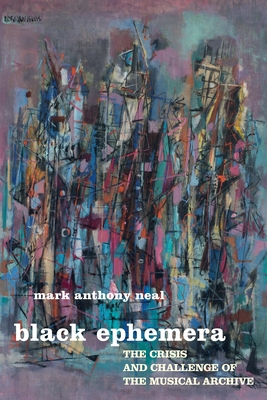 Black Ephemera: The Crisis and Challenge of the Musical Archive
Black Ephemera: The Crisis and Challenge of the Musical Archive
by Mark Anthony NealNew York University Press (Mar 08, 2022)
Read Detailed Book Description
A framework for understanding the deep archive of Black performance in the digital era
In an era of Big Data and algorithms, our easy access to the archive of contemporary and historical Blackness is unprecedented. That iterations of Black visual art, such as Bert Williams’s 1916 silent film short "A Natural Born Gambler" or the performances of Josephine Baker from the 1920s, are merely a quick YouTube search away has transformed how scholars teach and research Black performance.
While Black Ephemera celebrates this new access, it also questions the crisis and the challenge of the Black musical archive in a moment when Black American culture has become a global export. Using music and sound as its primary texts, Black Ephemera argues that the cultural DNA of Black America has become obscured in the transformation from analog to digital. Through a cross-reading of the relationship between the digital era and culture produced in the pre-digital era, Neal argues that Black music has itself been reduced to ephemera, at best, and at worst to the background sounds of the continued exploitation and commodification of Black culture. The crisis and challenges of Black archives are not simply questions of knowledge, but of how knowledge moves and manifests itself within Blackness that is obscure, ephemeral, fugitive, precarious, fluid, and increasingly digital.
Black Ephemera is a reminder that for every great leap forward there is a necessary return to the archive. Through this work, Neal offers a new framework for thinking about Black culture in the digital world.
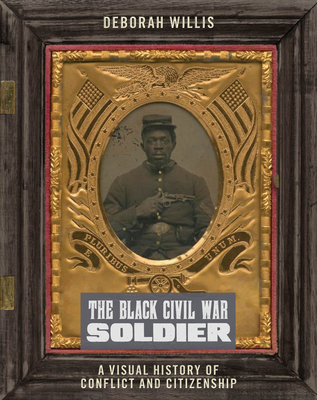 The Black Civil War Soldier: A Visual History of Conflict and Citizenship
The Black Civil War Soldier: A Visual History of Conflict and Citizenship
by Deborah WillisNew York University Press (Jan 26, 2021)
Read Detailed Book Description
A stunning collection of stoic portraits and intimate ephemera from the lives of Black Civil War soldiers
Though both the Union and Confederate armies excluded African American men from their initial calls to arms, many of the men who eventually served were black. Simultaneously, photography culture blossomed—marking the Civil War as the first conflict to be extensively documented through photographs. In The Black Civil War Soldier, Deb Willis explores the crucial role of photography in (re)telling and shaping African American narratives of the Civil War, pulling from a dynamic visual archive that has largely gone unacknowledged.
With over seventy images, The Black Civil War Soldier contains a huge breadth of primary and archival materials, many of which are rarely reproduced. The photographs are supplemented with handwritten captions, letters, and other personal materials; Willis not only dives into the lives of black Union soldiers, but also includes stories of other African Americans involved with the struggle—from left-behind family members to female spies. Willis thus compiles a captivating memoir of photographs and words and examines them together to address themes of love and longing; responsibility and fear; commitment and patriotism; and—most predominantly—African American resilience.
The Black Civil War Soldier offers a kaleidoscopic yet intimate portrait of the African American experience, from the beginning of the Civil War to 1900. Through her multimedia analysis, Willis acutely pinpoints the importance of African American communities in the development and prosecution of the war. The book shows how photography helped construct a national vision of blackness, war, and bondage, while unearthing the hidden histories of these black Civil War soldiers. In combating the erasure of this often overlooked history, Willis asks how these images might offer a more nuanced memory of African-American participation in the Civil War, and in doing so, points to individual and collective struggles for citizenship and remembrance.
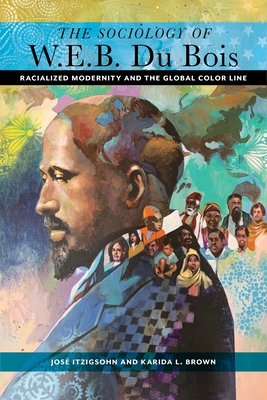 The Sociology of W. E. B. Du Bois: Racialized Modernity and the Global Color Line
The Sociology of W. E. B. Du Bois: Racialized Modernity and the Global Color Line
by José Itzigsohn and Karida L. BrownNew York University Press (Mar 24, 2020)
Read Detailed Book Description
The first comprehensive understanding of Du Bois for social scientists
The Sociology of W. E. B. Du Bois provides a comprehensive introduction to the founding father of American sociological thought. Du Bois is now recognized as a pioneer of American scientific sociology and as someone who made foundational contributions to the sociology of race and to urban and community sociology. However, in this authoritative volume, noted scholars José Itzigsohn and Karida L. Brown provide a groundbreaking account of Du Bois’s theoretical contribution to sociology, or what they call the analysis of "racialized modernity." Further, they examine the implications of developing a Du Boisian sociology for the practice of the discipline today.
The full canon of Du Bois’s sociological works spans a lifetime of over ninety years in which his ideas evolved over much of the twentieth century. This broader and more systematic account of Du Bois’s contribution to sociology explores how his theories changed, evolved, and even developed to contradict earlier ideas. Careful parsing of seminal works provides a much needed overview for students and scholars looking to gain a better grasp of the ideas of Du Bois, in particular his understanding of racialized subjectivity, racialized social systems, and his scientific sociology. Further, the authors show that a Du Boisian sociology provides a robust analytical framework for the multilevel examination of individual-level processes-such as the formation of the self-and macro processes-such as group formation and mobilization or the structures of modernity-key concepts for a basic understanding of sociology.
 We Are Worth Fighting for: A History of the Howard University Student Protest of 1989
We Are Worth Fighting for: A History of the Howard University Student Protest of 1989
by Joshua M. MyersNew York University Press (Dec 24, 2019)
Read Detailed Book Description
The Howard University protests from the perspective and worldview of its participants
We Are Worth Fighting For is the first history of the 1989 Howard University protest. The three-day occupation of the university’s Administration Building was a continuation of the student movements of the sixties and a unique challenge to the politics of the eighties. Upset at the university’s appointment of the Republican strategist Lee Atwater to the Board of Trustees, students forced the issue by shutting down the operations of the university. The protest, inspired in part by the emergence of "conscious" hip hop, helped to build support for the idea of student governance and drew upon a resurgent black nationalist ethos.
At the center of this story is a student organization known as Black Nia F.O.R.C.E. This group, co-founded by Ras J. Baraka (current mayor of Newark, NJ) and later led by current cultural arts entrepreneur April R. Silver, was at the forefront of organizing the student mobilization at Howard during the spring of 1989 and thereafter.
We Are Worth Fighting For explores how young Black student activists helped shape and resist the rightward shift and neoliberal foundations of American politics. This history adds to the literature on Black campus activism, Black Power studies, and the emerging histories of African American life in the 1980s.
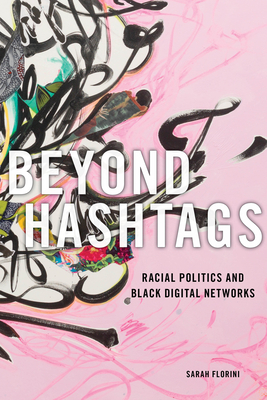 Beyond Hashtags: Racial Politics and Black Digital Networks
Beyond Hashtags: Racial Politics and Black Digital Networks
by Sarah FloriniNew York University Press (Dec 03, 2019)
Read Detailed Book Description
How black Americans use digital networks to organize and cultivate solidarity
Unrest gripped Ferguson, Missouri, after Mike Brown, an unarmed black teenager, was shot and killed by Officer Darren Wilson in August 2014. Many black Americans turned to their digital and social media networks to circulate information, cultivate solidarity, and organize during that tumultuous moment. While Ferguson and the subsequent protests made black digital networks visible to mainstream media, these networks did not coalesce overnight. They were built and maintained over years through common, everyday use.
Beyond Hashtags explores these everyday practices and their relationship to larger social issues through an in-depth analysis of a trans-platform network of black American digital and social media users and content creators. In the crucial years leading up to the emergence of the Movement for Black Lives, black Americans used digital networks not only to cope with day-to-day experiences of racism, but also as an incubator for the debates that have since exploded onto the national stage. Beyond Hashtags tells the story of an influential subsection of these networks, an assemblage of podcasting, independent media, Instagram, Vine, Facebook, and the network of Twitter users that has come to be known as "Black Twitter." Florini looks at how black Americans use these technologies often simultaneously to create a space to reassert their racial identities, forge community, organize politically, and create alternative media representations and news sources. Beyond Hashtags demonstrates how much insight marginalized users have into technology.
 Times Square Red, Times Square Blue
Times Square Red, Times Square Blue
by Samuel R. DelanyNew York University Press (Apr 30, 2019)
Read Detailed Book Description
Twentieth anniversary edition of a landmark book that cataloged a vibrant but disappearing neighborhood in New York City
In the two decades that preceded the original publication of Times Square Red, Times Square Blue, Forty-second Street, then the most infamous street in America, was being remade into a sanitized tourist haven. In the forced disappearance of porn theaters, peep shows, and street hustlers to make room for a Disney store, a children's theater, and large, neon-lit cafes, Samuel R. Delany saw a disappearance, not only of the old Times Square, but of the complex social relationships that developed there.
Samuel R. Delany bore witness to the dismantling of the institutions that promoted points of contact between people of different classes and races in a public space, and in this hybrid text, argues for the necessity of public restrooms and tree-filled parks to a city’s physical and psychological landscape.
This twentieth anniversary edition includes a new foreword by Robert F. Reid-Pharr that traces the importance and continued resonances of Samuel R. Delany’s groundbreaking Times Square Red, Times Square Blue.
 Algorithms Of Oppression: How Search Engines Reinforce Racism
Algorithms Of Oppression: How Search Engines Reinforce Racism
by Safiya Umoja NobleNew York University Press (Feb 18, 2018)
Read Detailed Book Description
Algorithms Of Oppression is a revealing look at how negative biases against women of color are embedded in search engine results and algorithms.
Run a Google search for “black girls”-what will you find? “Big Booty” and other sexually explicit terms are likely to come up as top search terms. But, if you type in “white girls,” the results are radically different. The suggested porn sites and un-moderated discussions about “why black women are so sassy” or “why black women are so angry” presents a disturbing portrait of black womanhood in modern society.
In Algorithms of Oppression, Safiya Umoja Noble challenges the idea that search engines like Google offer an equal playing field for all forms of ideas, identities, and activities. Data discrimination is a real social problem; Noble argues that the combination of private interests in promoting certain sites, along with the monopoly status of a relatively small number of Internet search engines, leads to a biased set of search algorithms that privilege whiteness and discriminate against people of color, specifically women of color.
Through an analysis of textual and media searches as well as extensive research on paid online advertising, Noble exposes a culture of racism and sexism in the way discoverability is created online. As search engines and their related companies grow in importance-operating as a source for email, a major vehicle for primary and secondary school learning, and beyond-understanding and reversing these disquieting trends and discriminatory practices is of utmost importance.
An original, surprising and, at times, disturbing account of bias on the internet, Algorithms of Oppression contributes to our understanding of how racism is created, maintained, and disseminated in the 21st century.
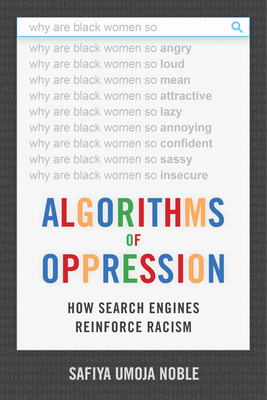 Algorithms Of Oppression (Hardcover)
Algorithms Of Oppression (Hardcover)
by Safiya Umoja NobleNew York University Press (Feb 18, 2018)
Read Detailed Book Description
Algorithms Of Oppression is a revealing look at how negative biases against women of color are embedded in search engine results and algorithms.
Run a Google search for “black girls”-what will you find? “Big Booty” and other sexually explicit terms are likely to come up as top search terms. But, if you type in “white girls,” the results are radically different. The suggested porn sites and un-moderated discussions about “why black women are so sassy” or “why black women are so angry” presents a disturbing portrait of black womanhood in modern society.
In Algorithms of Oppression, Safiya Umoja Noble challenges the idea that search engines like Google offer an equal playing field for all forms of ideas, identities, and activities. Data discrimination is a real social problem; Noble argues that the combination of private interests in promoting certain sites, along with the monopoly status of a relatively small number of Internet search engines, leads to a biased set of search algorithms that privilege whiteness and discriminate against people of color, specifically women of color.
Through an analysis of textual and media searches as well as extensive research on paid online advertising, Noble exposes a culture of racism and sexism in the way discoverability is created online. As search engines and their related companies grow in importance-operating as a source for email, a major vehicle for primary and secondary school learning, and beyond-understanding and reversing these disquieting trends and discriminatory practices is of utmost importance.
An original, surprising and, at times, disturbing account of bias on the internet, Algorithms of Oppression contributes to our understanding of how racism is created, maintained, and disseminated in the 21st century.
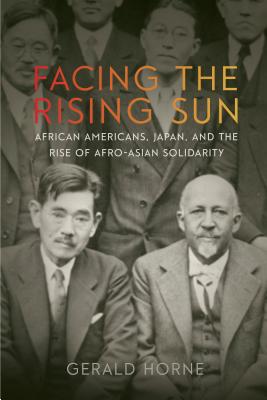 Facing the Rising Sun: African Americans, Japan, and the Rise of Afro-Asian Solidarity
Facing the Rising Sun: African Americans, Japan, and the Rise of Afro-Asian Solidarity
by Gerald HorneNew York University Press (Jan 16, 2018)
Read Detailed Book Description
The surprising alliance between Japan and pro-Tokyo African Americans during World War II In November 1942 in East St. Louis, Illinois a group of African Americans engaged in military drills were eagerly awaiting a Japanese invasion of the U.S.— an invasion that they planned to join. Since the rise of Japan as a superpower less than a century earlier, African Americans across class and ideological lines had saluted the Asian nation, not least because they thought its very existence undermined the pervasive notion of “white supremacy.” The list of supporters included Booker T. Washington, Marcus Garvey, and particularly W.E.B. Du Bois. Facing the Rising Sun tells the story of the widespread pro-Tokyo sentiment among African Americans during World War II, arguing that the solidarity between the two groups was significantly corrosive to the U.S. war effort. Gerald Horne demonstrates that Black Nationalists of various stripes were the vanguard of this trend—including followers of Garvey and the precursor of the Nation of Islam. Indeed, many of them called themselves “Asiatic”, not African. Following World War II, Japanese-influenced “Afro-Asian” solidarity did not die, but rather foreshadowed Dr. Martin Luther King’s tie to Gandhi’s India and Black Nationalists’ post-1970s fascination with Maoist China and Ho’s Vietnam. Based upon exhaustive research, including the trial transcripts of the pro-Tokyo African Americans who were tried during the war, congressional archives and records of the Negro press, this book also provides essential background for what many analysts consider the coming “Asian Century.” An insightful glimpse into the Black Nationalists’ struggle for global leverage and new allies, Facing the Rising Sun provides a complex, holistic perspective on a painful period in African American history, and a unique glimpse into the meaning of “the enemy of my enemy is my friend.”
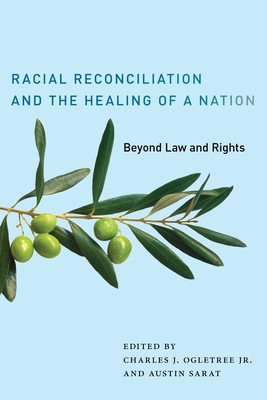 Racial Reconciliation and the Healing of a Nation: Beyond Law and Rights
Racial Reconciliation and the Healing of a Nation: Beyond Law and Rights
by Austin Sarat and Charles J. Ogletree, Jr.New York University Press (Oct 24, 2017)
Read Detailed Book Description
The work at hand for bridging the racial divide in the United States
From Baltimore and Ferguson to Flint and Charleston, the dream of a post-racial era in America has run up against the continuing reality of racial antagonism. Current debates about affirmative action, multiculturalism, and racial hate speech reveal persistent uncertainty and ambivalence about the place and meaning of race - and especially the black/white divide - in American culture. They also suggest that the work of racial reconciliation remains incomplete.
Racial Reconciliation and the Healing of a Nation seeks to assess where we are in that work, examining sources of continuing racial antagonism among blacks and whites. It also highlights strategies that promise to promote racial reconciliation in the future.
Rather than revisit arguments about the importance of integration, assimilation, and reparations, the contributors explore previously unconsidered perspectives on reconciliation between blacks and whites. Chapters connect identity politics, the rhetoric of race and difference, the work of institutions and actors in those institutions, and structural inequities in the lives of blacks and whites to our thinking about tolerance and respect.
Going beyond an assessment of the capacity of law to facilitate racial reconciliation, Racial Reconciliation and the Healing of a Nation challenges readers to examine social, political, cultural, and psychological issues that fuel racial antagonism, as well as the factors that might facilitate racial reconciliation.
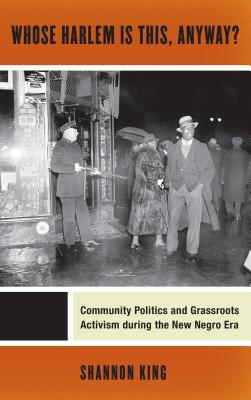 Whose Harlem Is This, Anyway?: Community Politics and Grassroots Activism during the New Negro Era
Whose Harlem Is This, Anyway?: Community Politics and Grassroots Activism during the New Negro Era
by Shannon KingNew York University Press (Apr 01, 2017)
Read Detailed Book Description
Read the Introduction from Whose Harlem Is This, Anyway? (pdf file)
2015 Choice Outstanding Academic Title Winner of the Anna Julia Cooper/CLR James Award for Outstanding Book in Africana Studies presented by the National Council for Black Studies
Demonstrates how Harlemite’s dynamic fight for their rights and neighborhood raised the black community’s racial consciousness and established Harlem’s legendary political culture
In Whose Harlem Is This, Anyway?, Shannon King vividly uncovers early twentieth century Harlem as an intersection between the black intellectuals and artists who created the New Negro Renaissance and the working class who found fought daily to combat institutionalized racism and gender discrimination in both Harlem and across the city.
New Negro activists, such as Hubert Harrison and Frank Crosswaith, challenged local forms of economic and racial inequality in attempts to breakdown the structural manifestations that upheld them. Insurgent stay-at-home black mothers took negligent landlords to court, complaining to magistrates about the absence of hot water and heat in their apartment buildings. Black men and women, propelling dishes, bricks, and other makeshift weapons from their apartment windows and their rooftops, retaliated against hostile policemen harassing blacks on the streets of Harlem. From the turn of the twentieth century to the Great Depression, black Harlemites mobilized around local issues—such as high rents, jobs, leisure, and police brutality—to make their neighborhood an autonomous black community.
In Whose Harlem Is This, Anyway?, Shannon King demonstrates how, against all odds, the Harlemite’s dynamic fight for their rights and neighborhood raised the black community’s racial consciousness and established Harlem’s legendary political culture. By the end of the 1920s, Harlem had experienced a labor strike, a tenant campaign for affordable rents, and its first race riot. These public forms of protest and discontent represented the dress rehearsal for black mass mobilization in the 1930s and 1940s. By studying blacks’ immense investment in community politics, King makes visible the hidden stirrings of a social movement deeply invested in a Black Harlem. Whose Harlem Is This, Anyway? Is a vibrant story of the shaping of a community during a pivotal time in American History.
 Archives of Flesh: African America, Spain, and Post-Humanist Critique
Archives of Flesh: African America, Spain, and Post-Humanist Critique
by Robert F. Reid-PharrNew York University Press (Dec 13, 2016)
Read Detailed Book Description
Enlists the principles of post-humanist critique in order to investigate decades of intimate dialogues between African American and Spanish intellectuals
In Archives of Flesh, Robert Reid-Pharr reveals the deep history of intellectual engagement between African America and Spain. Opening a fascinating window onto Black and anti-Fascist intellectual life from 1898 through the mid-1950s, Reid-Pharr argues that key institutions of Western Humanism, including American colleges and universities, developed in intimate relation to slavery, colonization, and white supremacy. This retreat to rigidly established philosophical and critical traditions can never fully address—or even fully recognize—the deep-seated hostility to Black subjectivity underlying the humanist ideal of a transcendent Manhood.
Calling for a specifically anti-white supremacist reexamination of the archives of Black subjectivity and resistance, Reid-Pharr enlists the principles of post-humanist critique in order to investigate decades of intimate dialogues between African American and Spanish intellectuals, including Salaria Kea, Federico García Lorca, Nella Larsen, Langston Hughes, Richard Wright, Chester Himes, Lynn Nottage, and Pablo Picasso. In the process, Reid-Pharr takes up the “African American Spanish Archive” in order to resist the anti-corporeal, anti-Black, anti-human biases that stand at the heart of Western Humanism.
 The Price of Paradise: The Costs of Inequality and a Vision for a More Equitable America
The Price of Paradise: The Costs of Inequality and a Vision for a More Equitable America
by David Dante TrouttNew York University Press (Nov 01, 2016)
Read Detailed Book Description
American communities are facing chronic problems: fiscal stress, urban decline, environmental sprawl, mass incarceration, political isolation, disproportionate foreclosures and severe public health risks. In The Price of Paradise, David Troutt argues that it is a lack of mutuality in our local decision making that has led to this looming crisis facing cities and local governments.
Arguing that there are structural flaws in the American dream, Troutt investigates the role that place plays in our thinking and how we have organized our communities to create or deny opportunity. Legal rules and policies that promoted mobility for most citizens simultaneously stifled and segregated a growing minority by race, class and—most importantly—place.
A conversation about America at the crossroads, The Price of Paradise is a multilayered exploration of the legal, economic and cultural forces that contribute to the squeeze on the middle class, the hidden dangers of growing income and wealth inequality and the literature on how growth and consumption patterns are environmentally unsustainable.
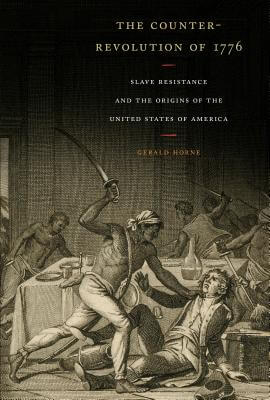 The Counter-Revolution of 1776: Slave Resistance and the Origins of the United States of America
The Counter-Revolution of 1776: Slave Resistance and the Origins of the United States of America
by Gerald HorneNew York University Press (Sep 01, 2016)
Read Detailed Book Description
The successful 1776 revolt against British rule in North America has been hailed almost universally as a great step forward for humanity. But the Africans then living in the colonies overwhelmingly sided with the British. In this trailblazing book, Gerald Horne shows that in the prelude to 1776, the abolition of slavery seemed all but inevitable in London, delighting Africans as much as it outraged slaveholders, and sparking the colonial revolt.
Prior to 1776, anti-slavery sentiments were deepening throughout Britain and in the Caribbean, rebellious Africans were in revolt. For European colonists in America, the major threat to their security was a foreign invasion combined with an insurrection of the enslaved. It was a real and threatening possibility that London would impose abolition throughout the colonies—a possibility the founding fathers feared would bring slave rebellions to their shores. To forestall it, they went to war.
The so-called Revolutionary War, Horne writes, was in part a counter-revolution, a conservative movement that the founding fathers fought in order to preserve their right to enslave others. The Counter-Revolution of 1776 brings us to a radical new understanding of the traditional heroic creation myth of the United States.
 Punishment in Popular Culture
Punishment in Popular Culture
by Austin Sarat and Charles J. Ogletree, Jr.New York University Press (Jun 05, 2015)
Read Detailed Book Description
The way a society punishes demonstrates its commitment to standards of judgment and justice, its distinctive views of blame and responsibility, and its particular way of responding to evil. Punishment in Popular Culture examines the cultural presuppositions that undergird America’s distinctive approach to punishment and analyzes punishment as a set of images, a spectacle of condemnation. It recognizes that the semiotics of punishment is all around us, not just in the architecture of the prison, or the speech made by a judge as she sends someone to the penal colony, but in both "high" and "popular" culture iconography, in novels, television, and film. This book brings together distinguished scholars of punishment and experts in media studies in an unusual juxtaposition of disciplines and perspectives.
Americans continue to lock up more people for longer periods of time than most other nations, to use the death penalty, and to racialize punishment in remarkable ways. How are these facts of American penal life reflected in the portraits of punishment that Americans regularly encounter on television and in film? What are the conventions of genre which help to familiarize those portraits and connect them to broader political and cultural themes? Do television and film help to undermine punishment’s moral claims? And how are developments in the broader political economy reflected in the ways punishment appears in mass culture? Finally, how are images of punishment received by their audiences? It is to these questions that Punishment in Popular Culture is addressed.
 Against Wind and Tide: The African American Struggle Against the Colonization Movement
Against Wind and Tide: The African American Struggle Against the Colonization Movement
by Ousmane K. Power-GreeneNew York University Press (Sep 05, 2014)
Read Detailed Book Description
Against Wind and Tide tells the story of African Americans’ battle against the American Colonization Society (ACS), founded in 1816 with the intention to return free blacks to its colony Liberia. Although ACS members considered free black colonization in Africa a benevolent enterprise, most black leaders rejected the ACS, fearing that the organization sought forced removal. As Ousmane K. Power-Greene’s story shows, these African American anticolonizationists did not believe Liberia would ever be a true “black American homeland.”
In this study of anticolonization agitation, Power-Greene draws on newspapers, meeting minutes, and letters to explore the concerted effort on the part of nineteenth-century black activists, community leaders, and spokespersons to challenge the American Colonization Society’s attempt to make colonization of free blacks federal policy. The ACS insisted the plan embodied empowerment. The United States, they argued, would never accept free blacks as citizens, and the only solution to the status of free blacks was to create an autonomous nation that would fundamentally reject racism at its core. But the activists and reformers on the opposite side believed that the colonization movement was itself deeply racist and in fact one of the greatest obstacles for African Americans to gain citizenship in the United States.
Power-Greene synthesizes debates about colonization and emigration, situating this complex and enduring issue into an ever broader conversation about nation building and identity formation in the Atlantic world.
 The Delectable Negro: Human Consumption and Homoeroticism Within Us Slave Culture
The Delectable Negro: Human Consumption and Homoeroticism Within Us Slave Culture
by Vincent WoodardNew York University Press (Jun 27, 2014)
Read Detailed Book Description
Winner of the 2015 LGBT Studies Award presented by the Lambda Literary Foundation
A groundbreaking study of the connections between homoeroticism, cannibalism, and cultures of consumption in American literature and US slave culture.
Scholars of US and transatlantic slavery have largely ignored or dismissed accusations that Black Americans were cannibalized. Vincent Woodard takes the enslaved person’s claims of human consumption seriously, focusing on both the literal starvation of the slave and the tropes of cannibalism on the part of the slaveholder, and further draws attention to the ways in which Blacks experienced their consumption as a fundamentally homoerotic occurrence. The Delectable Negro explores these connections between homoeroticism, cannibalism, and cultures of consumption in the context of American literature and US slave culture.
Utilizing many staples of African American literature and culture, such as the slave narratives of Olaudah Equiano, Harriet Jacobs, and Frederick Douglass, as well as other less circulated materials like James L. Smith’s slave narrative, runaway slave advertisements, and numerous articles from Black newspapers published in the nineteenth century, Woodard traces the racial assumptions, political aspirations, gender codes, and philosophical frameworks that dictated both European and white American arousal towards Black males and hunger for Black male flesh. Woodard uses these texts to unpack how slaves struggled not only against social consumption, but also against endemic mechanisms of starvation and hunger designed to break them. He concludes with an examination of the controversial chain gang oral sex scene in Toni Morrison’s Beloved, suggesting that even at the end of the twentieth and beginning of the twenty-first century, we are still at a loss for language with which to describe Black male hunger within a plantation culture of consumption.
 The Divided Mind of the Black Church: Theology, Piety, and Public Witness
The Divided Mind of the Black Church: Theology, Piety, and Public Witness
by Raphael G. WarnockNew York University Press (Dec 06, 2013)
Read Detailed Book Description
#1 New York Times bestseller
“Essential reading for anyone interested in understanding and treating traumatic stress and the scope of its impact on society.” —Alexander McFarlane, Director of the Centre for Traumatic Stress Studies
A pioneering researcher transforms our understanding of trauma and offers a bold new paradigm for healing in this New York Times bestseller
Trauma is a fact of life. Veterans and their families deal with the painful aftermath of combat; one in five Americans has been molested; one in four grew up with alcoholics; one in three couples have engaged in physical violence. Dr. Bessel van der Kolk, one of the world’s foremost experts on trauma, has spent over three decades working with survivors. In The Body Keeps the Score, he uses recent scientific advances to show how trauma literally reshapes both body and brain, compromising sufferers’ capacities for pleasure, engagement, self-control, and trust. He explores innovative treatments—from neurofeedback and meditation to sports, drama, and yoga—that offer new paths to recovery by activating the brain’s natural neuroplasticity. Based on Dr. van der Kolk’s own research and that of other leading specialists, The Body Keeps the Score exposes the tremendous power of our relationships both to hurt and to heal—and offers new hope for reclaiming lives.
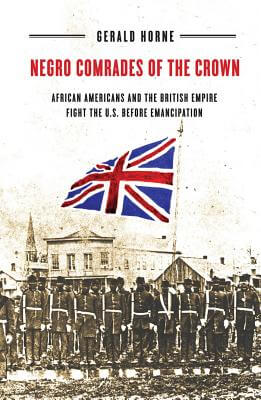 Negro Comrades of the Crown: African Americans and the British Empire Fight the U.S. Before Emancipation
Negro Comrades of the Crown: African Americans and the British Empire Fight the U.S. Before Emancipation
by Gerald HorneNew York University Press (Jul 26, 2013)
Read Detailed Book Description
While it is well known that more Africans fought on behalf of the British than with the successful patriots of the American Revolution, Gerald Horne reveals in his latest work of historical recovery that after 1776, Africans and African-Americans continued to collaborate with Great Britain against the United States in battles big and small until the Civil War.
Many African Americans viewed Britain, an early advocate of abolitionism and emancipator of its own slaves, as a powerful ally in their resistance to slavery in the Americas. This allegiance was far-reaching, from the Caribbean to outposts in North America to Canada. In turn, the British welcomed and actively recruited both fugitive and free African Americans, arming them and employing them in military engagements throughout the Atlantic World, as the British sought to maintain a foothold in the Americas following the Revolution.
In this path-breaking book, Horne rewrites the history of slave resistance by placing it for the first time in the context of military and diplomatic wrangling between Britain and the United States. Painstakingly researched and full of revelations, Negro Comrades of the Crown is among the first book-length studies to highlight the Atlantic origins of the Civil War, and the active role played by African Americans within these external factors that led to it. Listen to a one hour special with Dr. Gerald Horne on the "Sojourner Truth" radio show.
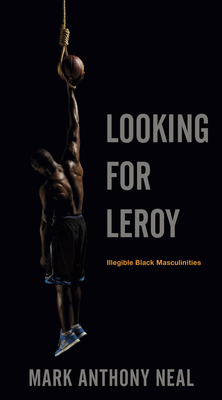 Looking for Leroy: Illegible Black Masculinities
Looking for Leroy: Illegible Black Masculinities
by Mark Anthony NealNew York University Press (Apr 22, 2013)
Read Detailed Book Description
Mark Anthony Neal’s Looking for Leroy is an engaging and provocative analysis of the complex ways in which black masculinity has been read and misread through contemporary American popular culture. Neal argues that black men and boys are bound, in profound ways, to and by their legibility. The most "legible" black male bodies are often rendered as criminal, bodies in need of policing and containment. Ironically, Neal argues, this sort of legibility brings welcome relief to white America, providing easily identifiable images of black men in an era defined by shifts in racial, sexual, and gendered identities.
Neal highlights the radical potential of rendering legible black male bodies—those bodies that are all too real for us—as illegible, while simultaneously rendering illegible black male bodies—those versions of black masculinity that we can’t believe are real—as legible. In examining figures such as hip-hop entrepreneur and artist Jay-Z, R&B Svengali R. Kelly, the late vocalist Luther Vandross, and characters from the hit HBO series The Wire, among others, Neal demonstrates how distinct representations of black masculinity can break the links in the public imagination that create antagonism toward black men. Looking for Leroy features close readings of contemporary black masculinity and popular culture, highlighting both the complexity and accessibility of black men and boys through visual and sonic cues within American culture, media, and public policy. By rendering legible the illegible, Neal maps the range of identifications and anxieties that have marked the performance and reception of post-Civil Rights era African American masculinity.
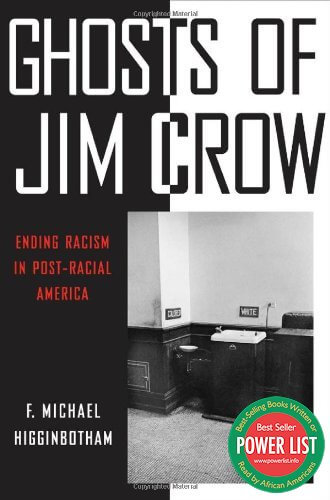 Ghosts Of Jim Crow
Ghosts Of Jim Crow
by F. Michael HigginbothamNew York University Press (Mar 13, 2013)
Read Detailed Book Description
When America inaugurated its first African American president, in 2009, many wondered if the country had finally become a "post-racial" society. Was this the dawning of a new era, in which America, a nation nearly severed in half by slavery, and whose racial fault lines are arguably among its most enduring traits, would at last move beyond race with the election of Barack Hussein Obama?
In Ghosts of Jim Crow, F. Michael Higginbotham convincingly argues that America remains far away from that imagined utopia. Indeed, the shadows of Jim Crow era laws and attitudes continue to perpetuate insidious, systemic prejudice and racism in the 21st century. Higginbotham’s extensive research demonstrates how laws and actions have been used to maintain a racial paradigm of hierarchy and separation—both historically, in the era of lynch mobs and segregation, and today—legally, economically, educationally and socially.
Using history as a road map, Higginbotham arrives at a provocative solution for ridding the nation of Jim Crow’s ghost, suggesting that legal and political reform can successfully create a post-racial America, but only if it inspires whites and blacks to significantly alter behaviors and attitudes of race-based superiority and victimization. He argues that America will never achieve its full potential unless it truly enters a post-racial era, and believes that time is of the essence as competition increases globally.
 Life Without Parole: America’s New Death Penalty?
Life Without Parole: America’s New Death Penalty?
by Austin Sarat and Charles J. Ogletree, Jr.New York University Press (Jun 04, 2012)
Read Detailed Book Description
Is life without parole the perfect compromise to the death penalty? Or is it as ethically fraught as capital punishment? This comprehensive, interdisciplinary anthology treats life without parole as "the new death penalty." Editors Charles J. Ogletree, Jr. and Austin Sarat bring together original work by prominent scholars in an effort to better understand the growth of life without parole and its social, cultural, political, and legal meanings. What justifies the turn to life imprisonment? How should we understand the fact that this penalty is used disproportionately against racial minorities? What are the most promising avenues for limiting, reforming, or eliminating life without parole sentences in the United States? Contributors explore the structure of life without parole sentences and the impact they have on prisoners, where the penalty fits in modern theories of punishment, and prospects for (as well as challenges to) reform.
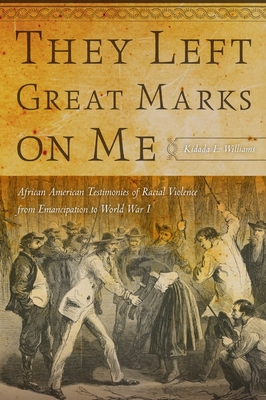 They Left Great Marks on Me: African American Testimonies of Racial Violence from Emancipation to World War I
They Left Great Marks on Me: African American Testimonies of Racial Violence from Emancipation to World War I
by Kidada E. WilliamsNew York University Press (Mar 12, 2012)
Read Detailed Book Description
Well after slavery was abolished, its legacy of violence left deep wounds on African Americans’ bodies, minds, and lives. For many victims and witnesses of the assaults, rapes, murders, nightrides, lynchings, and other bloody acts that followed, the suffering this violence engendered was at once too painful to put into words yet too horrible to suppress.
In this evocative and deeply moving history Kidada Williams examines African Americans’ testimonies about racial violence. By using both oral and print culture to testify about violence, victims and witnesses hoped they would be able to graphically disseminate enough knowledge about its occurrence and inspire Americans to take action to end it.
In the process of testifying, these people created a vernacular history of the violence they endured and witnessed, as well as the identities that grew from the experience of violence. This history fostered an oppositional consciousness to racial violence that inspired African Americans to form and support campaigns to end violence. The resulting crusades against racial violence became one of the political training grounds for the civil rights movement.
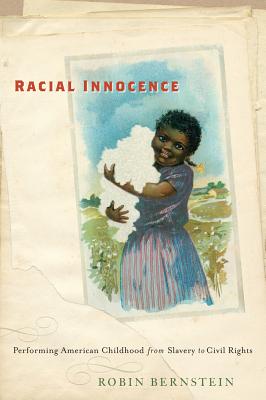 Racial Innocence: Performing American Childhood From Slavery To Civil Rights (America And The Long 19Th Century)
Racial Innocence: Performing American Childhood From Slavery To Civil Rights (America And The Long 19Th Century)
by Robin BernsteinNew York University Press (Dec 01, 2011)
Read Detailed Book Description
In Racial Innocence, Robin Bernstein argues that the concept of "childhood innocence" has been central to U.S. racial formation since the mid-nineteenth century. Children—white ones imbued with innocence, black ones excluded from it, and others of color erased by it—figured pivotally in sharply divergent racial agendas from slavery and abolition to antiblack violence and the early civil rights movement.
Bernstein takes up a rich archive including books, toys, theatrical props, and domestic knickknacks which she analyzes as "scriptive things" that invite or prompt historically-located practices while allowing for resistance and social improvisation. Integrating performance studies with literary and visual analysis, Bernstein offers singular readings of theatrical productions from blackface minstrelsy to Uncle Tom’s Cabin to The Wonderful Wizard of Oz; literary works by Joel Chandler Harris, Harriet Wilson, and Frances Hodgson Burnett; material culture including Topsy pincushions, Uncle Tom and Little Eva handkerchiefs, and Raggedy Ann dolls; and visual texts ranging from fine portraiture to advertisements for lard substitute. Throughout, Bernstein shows how "innocence" gradually became the exclusive province of white children—until the Civil Rights Movement succeeded not only in legally desegregating public spaces, but in culturally desegregating the concept of childhood itself.
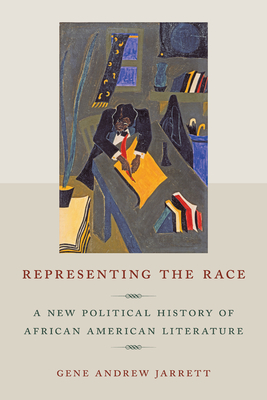 Representing the Race
Representing the Race
by Gene Andrew JarrettNew York University Press (Aug 08, 2011)
Read Detailed Book Description
The political value of African American literature has long been a topic of great debate among American writers, both black and white, from Thomas Jefferson to Barack Obama. In his compelling new book, Representing the Race, Gene Andrew Jarrett traces the genealogy of this topic in order to develop an innovative political history of African American literature. Jarrett examines texts of every sort—pamphlets, autobiographies, cultural criticism, poems, short stories, and novels—to parse the myths of authenticity, popular culture, nationalism, and militancy that have come to define African American political activism in recent decades. He argues that unless we show the diverse and complex ways that African American literature has transformed society, political myths will continue to limit our understanding of this intellectual tradition.Cultural forums ranging from the printing press, schools, and conventions, to parlors, railroad cars, and courtrooms provide the backdrop to this African American literary history, while the foreground is replete with compelling stories, from the debate over racial genius in early American history and the intellectual culture of racial politics after slavery, to the tension between copyright law and free speech in contemporary African American culture, to the political audacity of Barack Obama’s creative writing. Erudite yet accessible, Representing the Race is a bold explanation of what’s at stake in continuing to politicize African American literature in the new millennium.
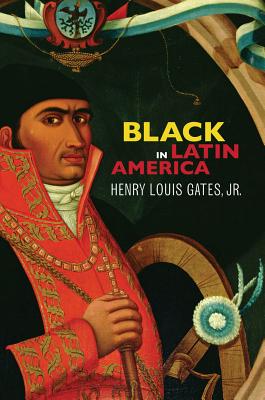 Black in Latin America
Black in Latin America
by Henry Louis Gates, Jr.New York University Press (Jul 27, 2011)
Read Detailed Book Description
Selected as a 2012 Outstanding Title by AAUP University Press Books for Public and Secondary School Libraries
12.5 million Africans were shipped to the New World during the Middle Passage. While just over 11.0 million survived the arduous journey, only about 450,000 of them arrived in the United States. The rest—over ten and a half million—were taken to the Caribbean and Latin America. This astonishing fact changes our entire picture of the history of slavery in the Western hemisphere, and of its lasting cultural impact. These millions of Africans created new and vibrant cultures, magnificently compelling syntheses of various African, English, French, Portuguese, and Spanish influences. Despite their great numbers, the cultural and social worlds that they created remain largely unknown to most Americans, except for certain popular, cross-over musical forms. So Henry Louis Gates, Jr. set out on a quest to discover how Latin Americans of African descent live now, and how the countries of their acknowledge—or deny—their African past; how the fact of race and African ancestry play themselves out in the multicultural worlds of the Caribbean and Latin America. Starting with the slave experience and extending to the present, Gates unveils the history of the African presence in six Latin American countries—Brazil, Cuba, the Dominican Republic, Haiti, Mexico, and Peru—through art, music, cuisine, dance, politics, and religion, but also the very palpable presence of anti-black racism that has sometimes sought to keep the black cultural presence from view. In Brazil, he delves behind the façade of Carnaval to discover how this ‘rainbow nation’ is waking up to its legacy as the world’s largest slave economy. In Cuba, he finds out how the culture, religion, politics and music of this island is inextricably linked to the huge amount of slave labor imported to produce its enormously profitable 19th century sugar industry, and how race and racism have fared since Fidel Castro’s Communist revolution in 1959. In Haiti, he tells the story of the birth of the first-ever black republic, and finds out how the slaves’s hard fought liberation over Napoleon Bonaparte’s French Empire became a double-edged sword. In Mexico and Peru, he explores the almost unknown history of the significant numbers of black people—far greater than the number brought to the United States—brought to these countries as early as the sixteenth and seventeenth centuries, and the worlds of culture that their descendants have created in Vera Cruz on the Gulf of Mexico, the Costa Chica region on the Pacific, and in and around Lima, Peru. Professor Gates’ journey becomes ours as we are introduced to the faces and voices of the descendants of the Africans who created these worlds. He shows both the similarities and distinctions between these cultures, and how the New World manifestations are rooted in, but distinct from, their African antecedents. “Black in Latin America” is the third instalment of Gates’s documentary trilogy on the Black Experience in Africa, the United States, and in Latin America. In America Behind the Color Line, Professor Gates examined the fortunes of the black population of modern-day America. In Wonders of the African World, he embarked upon a series of journeys to reveal the history of African culture. Now, he brings that quest full-circle in an effort to discover how Africa and Europe combined to create the vibrant cultures of Latin America, with a rich legacy of thoughtful, articulate subjects whose stories are astonishingly moving and irresistibly compelling.
 More Beautiful and More Terrible: The Embrace and Transcendence of Racial Inequality in the United States
More Beautiful and More Terrible: The Embrace and Transcendence of Racial Inequality in the United States
by Imani PerryNew York University Press (Feb 28, 2011)
Read Detailed Book Description
"Perry offers an insightful ’third way’ analysis…the book…is a good fit for cutting-edge graduate and faculty research."-M. Christian, Choice
 The Road to Abolition?: The Future of Capital Punishment in the United States
The Road to Abolition?: The Future of Capital Punishment in the United States
by Austin Sarat and Charles J. Ogletree, Jr.New York University Press (Nov 18, 2009)
Read Detailed Book Description
At the start of the twenty-first century, America is in the midst of a profound national reconsideration of the death penalty. There has been a dramatic decline in the number of people being sentenced to death as well as executed, exonerations have become common, and the number of states abolishing the death penalty is on the rise. The essays featured in The Road to Abolition? track this shift in attitudes toward capital punishment, and consider whether or not the death penalty will ever be abolished in America.
The interdisciplinary group of experts gathered by Charles J. Ogletree Jr., and Austin Sarat ask and attempt to answer the hard questions that need to be addressed if the death penalty is to be abolished. Will the death penalty end only to be replaced with life in prison without parole? Will life without the possibility of parole become, in essence, the new death penalty? For abolitionists, might that be a pyrrhic victory? The contributors discuss how the death penalty might be abolished, with particular emphasis on the current debate over lethal injection as a case study on why and how the elimination of certain forms of execution might provide a model for the larger abolition of the death penalty.
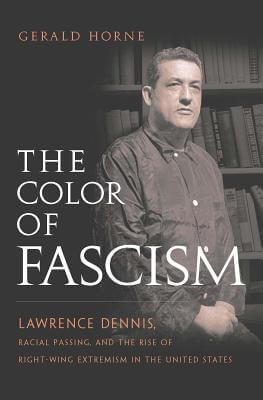 The Color of Fascism: Lawrence Dennis, Racial Passing, and the Rise of Right-Wing Extremism in the United States
The Color of Fascism: Lawrence Dennis, Racial Passing, and the Rise of Right-Wing Extremism in the United States
by Gerald HorneNew York University Press (Sep 01, 2009)
Read Detailed Book Description
What does it mean that Lawrence Dennis—arguably the “brains” behind U.S. fascism—was born black but spent his entire adult life passing for white? Born in Atlanta in 1893, Dennis began life as a highly touted African American child preacher, touring nationally and arousing audiences with his dark-skinned mother as his escort. However, at some point between leaving prep school and entering Harvard University, he chose to abandon his family and his former life as an African American in order to pass for white. Dennis went on to work for the State Department and on Wall Street, and ultimately became the public face of U.S. fascism, meeting with Mussolini and other fascist leaders in Europe. He underwent trial for sedition during World War II, almost landing in prison, and ultimately became a Cold War critic before dying in obscurity in 1977. Based on extensive archival research, The Color of Fascism blends biography, social history, and critical race theory to illuminate the fascinating life of this complex and enigmatic man. Gerald Horne links passing and fascism, the two main poles of Dennis’s life, suggesting that Dennis’s anger with the U.S. as a result of his upbringing in Jim Crow Georgia led him to alliances with the antagonists of the U.S. and that his personal isolation which resulted in his decision to pass dovetailed with his ultimate isolationism. Dennis’s life is a lasting testament to the resilience of right-wing thought in the U.S. The first full-scale biographical portrait of this intriguing figure, The Color of Fascism also links the strange career of a prominent American who chose to pass.
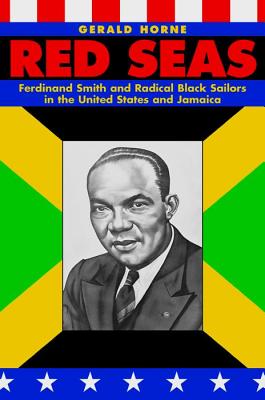 Red Seas: Ferdinand Smith and Radical Black Sailors in the United States and Jamaica
Red Seas: Ferdinand Smith and Radical Black Sailors in the United States and Jamaica
by Gerald HorneNew York University Press (Sep 01, 2009)
Read Detailed Book Description
During the heyday of the U.S. and international labor movements in the 1930s and 1940s, Ferdinand Smith, the Jamaican-born co-founder and second-in-command of the National Maritime Union (NMU), stands out as one of the most—if not the most—powerful black labor leaders in the United States. Smith’s active membership in the Communist Party, however, coupled with his bold labor radicalism and shaky immigration status, brought him under continual surveillance by U.S. authorities, especially during the Red Scare in the 1950s. Smith was eventually deported to his homeland of Jamaica, where he continued his radical labor and political organizing until his death in 1961.Gerald Horne draws on Smith’s life to make insightful connections between labor radicalism and the Civil Rights Movement—demonstrating that the gains of the latter were propelled by the former and undermined by anticommunism. Moreover, Red Seas uncovers the little-known experiences of black sailors and their contribution to the struggle for labor and civil rights, the history of the Communist Party and its black members, and the significant dimensions of Jamaican labor and political radicalism.
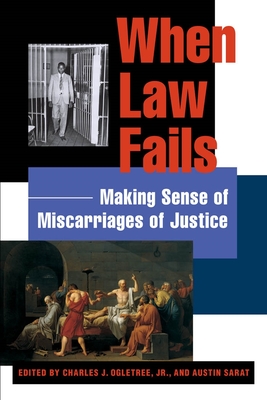 When Law Fails: Making Sense of Miscarriages of Justice
When Law Fails: Making Sense of Miscarriages of Justice
by Austin Sarat and Charles J. Ogletree, Jr.New York University Press (Jan 01, 2009)
Read Detailed Book Description
Since 1989, there have been over 200 post-conviction DNA exonerations in the United States. On the surface, the release of innocent people from prison could be seen as a victory for the criminal justice system: the wrong person went to jail, but the mistake was fixed and the accused set free. A closer look at miscarriages of justice, however, reveals that such errors are not aberrations but deeply revealing, common features of our legal system.
The ten original essays in When Law Fails view wrongful convictions not as random mistakes but as organic outcomes of a misshaped larger system that is rife with faulty eyewitness identifications, false confessions, biased juries, and racial discrimination. Distinguished legal thinkers Charles J. Ogletree, Jr., and Austin Sarat have assembled a stellar group of contributors who try to make sense of justice gone wrong and to answer urgent questions. Are miscarriages of justice systemic or symptomatic, or are they mostly idiosyncratic? What are the broader implications of justice gone awry for the ways we think about law? Are there ways of reconceptualizing legal missteps that are particularly useful or illuminating? These instructive essays both address the questions and point the way toward further discussion.
When Law Fails reveals the dramatic consequences as well as the daily realities of breakdowns in the law’s ability to deliver justice swiftly and fairly, and calls on us to look beyond headline-grabbing exonerations to see how failure is embedded in the legal system itself. Once we are able to recognize miscarriages of justice we will be able to begin to fix our broken legal system.
Contributors: Douglas A. Berman, Markus D. Dubber, Mary L. Dudziak, Patricia Ewick, Daniel Givelber, Linda Ross Meyer, Charles J. Ogletree, Jr., Austin Sarat, Jonathan Simon, and Robert Weisberg.
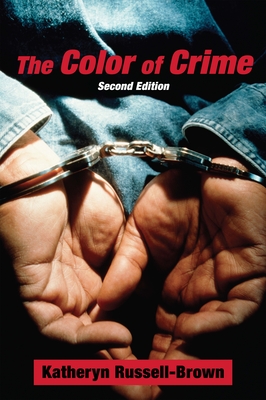 The Color of Crime (Second Edition): Racial Hoaxes, White Fear, Black Protectionism, Police Harassment, and Other Macroaggressions
The Color of Crime (Second Edition): Racial Hoaxes, White Fear, Black Protectionism, Police Harassment, and Other Macroaggressions
by Katheryn Russell-BrownNew York University Press (Dec 01, 2008)
Read Detailed Book Description
A lucid and forceful volume that explores the tacit and subtle ways the American justice system links deviance to people of color
When The Color of Crime was first published ten years ago, it was heralded as a path-breaking book on race and crime. Now, in its tenth anniversary year, Katheryn Russell-Brown’s book is more relevant than ever. The Jena Six, Duke Lacrosse Team, Amadou Diallo, Sean Bell, James Byrd, and all of those victimized in the aftermath of Hurricane Katrina are just a few of the racially fueled cases that have made headlines in the past decade.
Russell-Brown continues to ask, why do Black and White Americans perceive police actions so differently? Is White fear of Black crime justified? Do African Americans really protect their own? Should they? And why are we still talking about O.J.? Russell-Brown surveys the landscape of American crime and identifies some of the country’s most significant racial pathologies. In this new edition, each chapter is updated and revised, and two new chapters have been added. Enriched with twenty-five new cases, the explosive and troublesome chapter on "Racial Hoaxes" demonstrates that "playing the race card" is still a popular ploy.
The Color of Crime is a lucid and forceful volume that calls for continued vigilance on the part of journalists, scholars, and policymakers alike. Through her innovative analysis of cases, ideological and media trends, issues, and practices that resonate below the public radar even in the new century, Russell-Brown explores the tacit and subtle ways that deviance is systematically linked to people of color. Her findings are impossible to ignore.
 To the Break of Dawn: A Freestyle on the Hip Hop Aesthetic
To the Break of Dawn: A Freestyle on the Hip Hop Aesthetic
by William Jelani CobbNew York University Press (May 01, 2008)
Read Detailed Book Description
2007 Arts Club of Washington’s National Award for Arts Writing - Finalist
With roots that stretch from West Africa through the black pulpit, hip-hop emerged in the streets of the South Bronx in the 1970s and has spread to the farthest corners of the earth. To the Break of Dawn uniquely examines this freestyle verbal artistry on its own terms. A kid from Queens who spent his youth at the epicenter of this new art form, music critic William Jelani Cobb takes readers inside the beats, the lyrics, and the flow of hip-hop, separating mere corporate rappers from the creative MCs that forged the art in the crucible of the street jam.
The four pillars of hip hop—break dancing, graffiti art, deejaying, and rapping—find their origins in traditions as diverse as the Afro-Brazilian martial art Capoeira and Caribbean immigrants’ turnstile artistry. Tracing hip-hop’s relationship to ancestral forms of expression, Cobb explores the cultural and literary elements that are at its core. From KRS-One and Notorious B.I.G. to Tupac Shakur and Lauryn Hill, he profiles MCs who were pivotal to the rise of the genre, verbal artists whose lineage runs back to the black preacher and the bluesman.
Unlike books that focus on hip-hop as a social movement or a commercial phenomenon, To the Break of Dawn tracks the music’s aesthetic, stylistic, and thematic evolution from its inception to today’s distinctly regional sub-divisions and styles. Written with an insider’s ear, the book illuminates hip-hop’s innovations in a freestyle form that speaks to both aficionados and newcomers to the art.
 Once You Go Black: Choice, Desire, and the Black American Intellectual
Once You Go Black: Choice, Desire, and the Black American Intellectual
by Robert F. Reid-PharrNew York University Press (Jul 01, 2007)
Read Detailed Book Description
2007 Lambda Literary Award Finalist, LGBT Studies
Richard Wright. Ralph Ellison. James Baldwin. Literary and cultural critic Robert Reid-Pharr asserts that these and other post-World War II intellectuals announced the very themes of race, gender, and sexuality with which so many contemporary critics are now engaged. While at its most elemental Once You Go Black is an homage to these thinkers, it is at the same time a reconsideration of Black Americans as agents, and not simply products, of history. Reid-Pharr contends that our current notions of Black American identity are not inevitable, nor have they simply been forced onto the Black community. Instead, he argues, Black American intellectuals have actively chosen the identity schemes that seem to us so natural today.
Turning first to the late and relatively obscure novels of Wright, Ellison, and Baldwin, Reid-Pharr suggests that each of these authors rejects the idea of the Black as innocent. Instead, they insisted upon the responsibility of all citizens—even the most oppressed—within modern society. Reid-Pharr then examines a number of responses to this presumed erosion of Black innocence, paying particular attention to articulations of Black masculinity by Huey Newton, one of the two founders of the Black Panther Party, and Melvin Van Peebles, director of the classic film Sweet Sweetback’s Baadasssss Song.
Shuttling between queer theory, intellectual history, literary close readings, and autobiography, Once You Go Black is an impassioned, eloquent, and elegant call to bring the language of choice into the study of Black American literature and culture. At the same time, it represents a hard-headed rejection of the presumed inevitability of what Reid-Pharr names racial desire in the production of either culture or cultural studies.
 The Deepest South: The United States, Brazil, and the African Slave Trade
The Deepest South: The United States, Brazil, and the African Slave Trade
by Gerald HorneNew York University Press (Mar 01, 2007)
Read Detailed Book Description
During its heyday in the nineteenth century, the African slave trade was fueled by the close relationship of the United States and Brazil. The Deepest South tells the disturbing story of how U.S. nationals - before and after Emancipation — continued to actively participate in this odious commerce by creating diplomatic, social, and political ties with Brazil, which today has the largest population of African origin outside of Africa itself.Proslavery Americans began to accelerate their presence in Brazil in the 1830s, creating alliances there—sometimes friendly, often contentious—with Portuguese, Spanish, British, and other foreign slave traders to buy, sell, and transport African slaves, particularly from the eastern shores of that beleaguered continent. Spokesmen of the Slave South drew up ambitious plans to seize the Amazon and develop this region by deporting the enslaved African-Americans there to toil. When the South seceded from the Union, it received significant support from Brazil, which correctly assumed that a Confederate defeat would be a mortal blow to slavery south of the border. After the Civil War, many Confederates, with slaves in tow, sought refuge as well as the survival of their peculiar institution in Brazil.Based on extensive research from archives on five continents, Gerald Horne breaks startling new ground in the history of slavery, uncovering its global dimensions and the degrees to which its defenders went to maintain it.
 Pimps Up, Ho’s Down: Hip Hop’s Hold on Young Black Women
Pimps Up, Ho’s Down: Hip Hop’s Hold on Young Black Women
by T. Denean Sharpley-WhitingNew York University Press (Mar 01, 2007)
Read Detailed Book Description
2007 Popular Culture Association/American Culture Association Emily Toth AwardPimps Up, Ho’s Down pulls at the threads of the intricately knotted issues surrounding young black women and hip hop culture. What unravels for Tracy D. Sharpley-Whiting is a new, and problematic, politics of gender. In this fascinating and forceful book, Sharpley-Whiting, a feminist writer who is a member of the hip hop generation, interrogates the complexities of young black women’s engagement with a culture that is masculinist, misogynistic, and frequently mystifying.Beyond their portrayal in rap lyrics, the display of black women in music videos, television, film, fashion, and on the Internet is indispensable to the mass media engineered appeal of hip hop culture, the author argues. And the commercial trafficking in the images and behaviors associated with hip hop has made them appear normal, acceptable, and entertaining - both in the U.S. and around the world.Sharpley-Whiting questions the impacts of hip hop’s increasing alliance with the sex industry, the rise of groupie culture in the hip hop world, the impact of hip hop’s compulsory heterosexual culture on young black women, and the permeation of the hip hop ethos into young black women’s conceptions of love and romance. The author knows her subject from the inside. Coming of age in the midst of hip hop’s evolution in the late 1980s, she mixed her graduate studies with work as a runway and print model in the 1990s. Her book features interviews with exotic dancers, black hip hop groupies, and hip hop generation members Jacklyn “Diva” Bush, rapper Trina, and filmmaker Aishah Simmons, along with the voices of many “everyday” young women.Pimps Up, Ho’s Down turns down the volume and amplifies the substance of discussions about hip hop culture and to provide a space for young black women to be heard.
 To the Break of Dawn: A Freestyle on the Hip-Hop Aesthetic
To the Break of Dawn: A Freestyle on the Hip-Hop Aesthetic
by William Jelani CobbNew York University Press (Feb 01, 2007)
Read Detailed Book Description
2007 Arts Club of Washington’s National Award for Arts Writing - FinalistSEE ALSO: Pimps Up, Ho’s Down: Hip Hop’s Hold on Young Black Women by T. Denean Sharpley-Whiting.With roots that stretch from West Africa through the black pulpit, hip-hop emerged in the streets of the South Bronx in the 1970s and has spread to the farthest corners of the earth. To the Break of Dawn uniquely examines this freestyle verbal artistry on its own terms. A kid from Queens who spent his youth at the epicenter of this new art form, music critic William Jelani Cobb takes readers inside the beats, the lyrics, and the flow of hip-hop, separating mere corporate rappers from the creative MCs that forged the art in the crucible of the street jam.The four pillars of hip hop—break dancing, graffiti art, deejaying, and rapping—find their origins in traditions as diverse as the Afro-Brazilian martial art Capoeira and Caribbean immigrants’ turnstile artistry. Tracing hip-hop’s relationship to ancestral forms of expression, Cobb explores the cultural and literary elements that are at its core. From KRS-One and Notorious B.I.G. to Tupac Shakur and Lauryn Hill, he profiles MCs who were pivotal to the rise of the genre, verbal artists whose lineage runs back to the black preacher and the bluesman.Unlike books that focus on hip-hop as a social movement or a commercial phenomenon, To the Break of Dawn tracks the music’s aesthetic, stylistic, and thematic evolution from its inception to today’s distinctly regional sub-divisions and styles. Written with an insider’s ear, the book illuminates hip-hop’s innovations in a freestyle form that speaks to both aficionados and newcomers to the art.
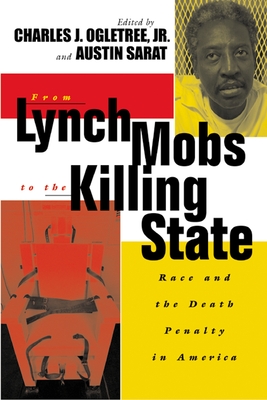 From Lynch Mobs to the Killing State: Race and the Death Penalty in America
From Lynch Mobs to the Killing State: Race and the Death Penalty in America
by Austin Sarat and Charles J. Ogletree, Jr.New York University Press (May 01, 2006)
Read Detailed Book Description
Since 1976, over forty percent of prisoners executed in American jails have been African American or Hispanic. This trend shows little evidence of diminishing and follows a larger pattern of the violent criminalization of African American populations that has marked the country’s history of punishment.
In a bold attempt to tackle the looming question of how and why the connection between race and the death penalty has been so strong throughout American history, Ogletree and Sarat headline an interdisciplinary cast of experts in reflecting on this disturbing issue. Insightful original essays approach the topic from legal, historical, cultural, and social science perspectives to show the ways that the death penalty is racialized, the places in the death penalty process where race makes a difference, and the ways that meanings of race in the United States are constructed in and through our practices of capital punishment.
From Lynch Mobs to the Killing State not only uncovers the ways that race influences capital punishment but also attempts to situate the linkage between race and the death penalty in the history of this country, in particular the history of lynching. In its probing examination of how and why the connection between race and the death penalty has been so strong throughout American history, this book forces us to consider how the death penalty gives meaning to race as well as why the racialization of the death penalty is uniquely American.
 African American Literature Beyond Race
African American Literature Beyond Race
by Gene Andrew JarrettNew York University Press (Apr 01, 2006)
Read Detailed Book Description
It is widely accepted that the canon of African American literature has racial realism at its core: African American protagonists, social settings, cultural symbols, and racial-political discourse. As a result, writings that are not preoccupied with race have long been invisible—unpublished, out of print, absent from libraries, rarely discussed among scholars, and omitted from anthologies.However, some of our most celebrated African American authors—from Zora Neale Hurston and Richard Wright to James Baldwin and Toni Morrison—have resisted this canonical rule, even at the cost of critical dismissal and commercial failure. African American Literature Beyond Race revives this remarkable literary corpus, presenting sixteen short stories, novelettes, and excerpts of novels-from the postbellum nineteenth century to the late twentieth century-that demonstrate this act of literary defiance. Each selection is paired with an original introduction by one of today’s leading scholars of African American literature, including Hazel V. Carby, Gerald Early, Mae G. Henderson, George Hutchinson, Carla Peterson, Amritjit Singh, and Werner Sollors.By casting African Americans in minor roles and marking the protagonists as racially white, neutral, or ambiguous, these works of fiction explore the thematic complexities of human identity, relations, and culture. At the same time, they force us to confront the basic question, "What is African American literature?"Stories by: James Baldwin, Octavia E. Butler, Samuel R. Delany, Paul Laurence Dunbar, Frances Ellen Watkins Harper, Chester B. Himes, Zora Neale Hurston, Nella Larsen, Toni Morrison, Ann Petry, Wallace Thurman, Jean Toomer, Frank J. Webb, Richard Wright, and Frank Yerby.Critical Introductions by: Hazel V. Carby, John Charles, Gerald Early, Hazel Arnett Ervin, Matthew Guterl, Mae G. Henderson, George B. Hutchinson, Gene Jarrett, Carla L. Peterson, Amritjit Singh, Werner Sollors, and Jeffrey Allen Tucker.
 The Games Black Girls Play: Learning the Ropes from Double-Dutch to Hip-Hop
The Games Black Girls Play: Learning the Ropes from Double-Dutch to Hip-Hop
by Kyra D. GauntNew York University Press (Feb 06, 2006)
Read Detailed Book Description
2007 Alan Merriam Prize presented by the Society for Ethnomusicology 2007 PEN/Beyond Margins Book Award FinalistWhen we think of African American popular music, our first thought is probably not of double-dutch: girls bouncing between two twirling ropes, keeping time to the tick-tat under their toes. But this book argues that the games black girls play —handclapping songs, cheers, and double-dutch jump rope—both reflect and inspire the principles of black popular musicmaking.The Games Black Girls Play illustrates how black musical styles are incorporated into the earliest games African American girls learn—how, in effect, these games contain the DNA of black music. Drawing on interviews, recordings of handclapping games and cheers, and her own observation and memories of gameplaying, Kyra D. Gaunt argues that black girls’ games are connected to long traditions of African and African American musicmaking, and that they teach vital musical and social lessons that are carried into adulthood. In this celebration of playground poetry and childhood choreography, she uncovers the surprisingly rich contributions of girls’ play to black popular culture.
 Race War!: White Supremacy and the Japanese Attack on the British Empire
Race War!: White Supremacy and the Japanese Attack on the British Empire
by Gerald HorneNew York University Press (Nov 01, 2005)
Read Detailed Book Description
Japan’s lightning march across Asia during World War II was swift and brutal. Nation after nation fell to Japanese soldiers. How were the Japanese able to justify their occupation of so many Asian nations? And how did they find supporters in countries they subdued and exploited? Race War! delves into submerged and forgotten history to reveal how European racism and colonialism were deftly exploited by the Japanese to create allies among formerly colonized people of color. Through interviews and original archival research on five continents, Gerald Horne shows how race played a key—and hitherto ignored—;role in each phase of the war.During the conflict, the Japanese turned white racism on its head portraying the war as a defense against white domination in the Pacific. We learn about the reverse racial hierarchy practiced by the Japanese internment camps, in which whites were placed at the bottom of the totem pole, under the supervision of Chinese, Korean, and Indian guards—an embarrassing example of racial payback that was downplayed by the defeated Japanese and the humiliated Europeans and Euro-Americans. Focusing on the microcosmic example of Hong Kong but ranging from colonial India to New Zealand and the shores of the U.S., Gerald Horne radically retells the story of the war. From racist U.S. propaganda to Black Nationalist open support of Imperial Japan, information about the effect of race on U.S. and British policy is revealed for the first time. This revisionist account of the war draws connections between General Tojo, Malaysian freedom fighters, and Elijah Muhammed of the Nation of Islam and shows how white racism encouraged and enabled Japanese imperialism. In sum, Horne demonstrates that the retreat of white supremacy was not only driven by the impact of the Cold War and the energized militancy of Africans and African-Americans but by the impact of the Pacific War as well, as a chastened U.S. and U.K. moved vigorously after this conflict to remove the conditions that made Japan’s success possible.
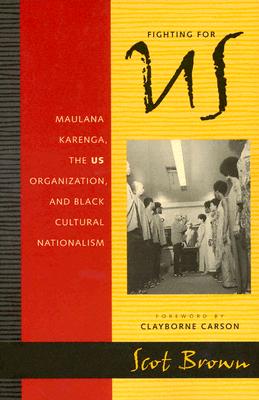 Fighting for Us
Fighting for Us
by Scot BrownNew York University Press (Mar 01, 2005)
Read Detailed Book Description
In spite of the ever-growing popularity of Kwanzaa, the story of the influential Black nationalist organization behind the holiday has never been told. Fighting for Us explores the fascinating history of the US Organization, a Black nationalist group based in California that played a leading role in Black Power politics and culture during the late 1960s and early ‘70s whose influence is still felt today. Advocates of Afrocentric renewal, US unleashed creative and intellectual passions that continue to fuel debate and controversy among scholars and students of the Black Power movement.Founded in 1965 by Maulana Karenga, US established an extensive network of alliances with a diverse body of activists, artists and organizations throughout the United States for the purpose of bringing about an African American cultural revolution. Fighting for US presents the first historical examination of US’ philosophy, internal dynamics, political activism and influence on African American art, making an elaborate use of oral history interviews, organizational archives, Federal Bureau of Investigation files, newspaper accounts, and other primary sources of the period.This book also sheds light on factors contributing to the organization’s decline in the early ‘70s—;government repression, authoritarianism, sexism, and elitist vanguard politics. Previous scholarship about US has been shaped by a war of words associated with a feud between US and the Black Panther Party that gave way to a series of violent and deadly clashes in Los Angeles. Venturing beyond the lingering rhetoric of rivalry, this book illuminates the ideological similarities and differences between US’s “cultural” nationalism and the Black Panther Party’s "revolutionary" nationalism. Today, US’s emphasis on culture has endured as evidenced by the popularity of Kwanzaa and the Afrocentrism in Black art and popular media. Engaging and original, Fighting for US will be the definitive work on Maulana Karenga, the US organization, and Black cultural nationalism in America.
 Black and Brown: African Americans and the Mexican Revolution, 1910-1920 (American History and Culture)
Black and Brown: African Americans and the Mexican Revolution, 1910-1920 (American History and Culture)
by Gerald HorneNew York University Press (Feb 01, 2005)
Read Detailed Book Description
Winner of a 2005 Gustavus Myers Outstanding Book Award (Honorable Mention)The Mexican Revolution was a defining moment in the history of race relations, impacting both Mexican and African Americans. For black Westerners, 1910?1920 did not represent the clear-cut promise of populist power, but a reordering of the complex social hierarchy which had, since the nineteenth century, granted them greater freedom in the borderlands than in the rest of the United States.Despite its lasting significance, the story of black Americans along the Mexican border has been sorely underreported in the annals of U.S. history. Gerald Horne brings the tale to life in Black and Brown. Drawing on archives on both sides of the border, a host of cutting-edge studies and oral histories, Horne chronicles the political currents which created and then undermined the Mexican border as a relative safe haven for African Americans. His account addresses blacks’ role as “Indian fighters,” the relationship between African Americans and immigrants, and the U.S. government’s growing fear of black disloyalty, among other essential concerns of the period: the heavy reliance of the U.S. on black soldiers along the border placed white supremacy and national security on a collision course that was ultimately resolved in favor of the latter. Mining a forgotten chapter in American history, Black and Brown offers tremendous insight into the past and future of race relations along the Mexican border.
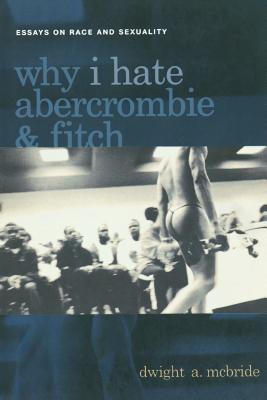 Why I Hate Abercrombie & Fitch: Essays On Race and Sexuality (Sexual Cultures)
Why I Hate Abercrombie & Fitch: Essays On Race and Sexuality (Sexual Cultures)
by Dwight McBrideNew York University Press (Feb 01, 2005)
Read Detailed Book Description
Why hate Abercrombie? In a world rife with human cruelty and oppression, why waste your scorn on a popular clothing retailer? The rationale, Dwight A. McBride argues, lies in “the banality of evil,” or the quiet way discriminatory hiring practices and racist ad campaigns seep into and reflect malevolent undertones in American culture.McBride maintains that issues of race and sexuality are often subtle and always messy, and his compelling new book does not offer simple answers. Instead, in a collection of essays about such diverse topics as biased marketing strategies, black gay media representations, the role of African American studies in higher education, gay personal ads, and pornography, he offers the evolving insights of one black gay male scholar. As adept at analyzing affirmative action as dissecting Queer Eye for the Straight Guy, McBride employs a range of academic, journalistic, and autobiographical writing styles. Each chapter speaks a version of the truth about black gay male life, African American studies, and the black community. Original and astute, Why I Hate Abercrombie & Fitch is a powerful vision of a rapidly changing social landscape.
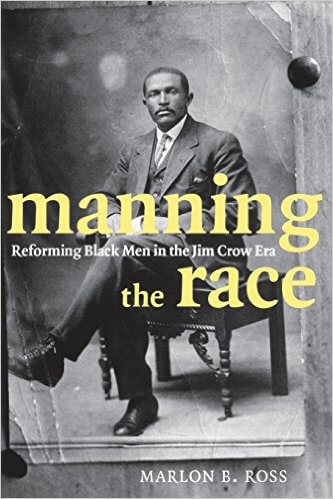 Manning the Race: Reforming Black Men in the Jim Crow Era
Manning the Race: Reforming Black Men in the Jim Crow Era
by Marlon B. RossNew York University Press (Jun 01, 2004)
Read Detailed Book Description
Manning the Race explores how African American men have been marketed, embodied, and imaged for the purposes of racial advancement during the early decades of the twentieth century. Marlon Ross provides an intellectual history of both famous and lesser-known men who have served—controversially—as models and foils for black masculine competence. Ross examines a host of early twentieth-century cultural sites where black masculinity struggles against Jim Crow: the mobilization of the New Negro; the sexual politics of autobiography in the post-emancipation generation; the emergence of black male sociology; sexual rivalry and networking in biracial uplift institutions; Negro Renaissance arts patronage; and the sexual construction of the black urban folk novel. Focusing on the overlooked dynamics of symbolic fraternity, intimate friendship, and erotic bonding within and across gender, Manning the Race is the first book to integrate same-sexuality into the cultural history of black manhood. By approaching black manhood as a culturally contested arena, this important new work reveals the changing meanings and enactments of race, gender, nation, and sexuality in modern America.
Manning the Race opens new approaches to the study of black manhood in relation to U.S. culture. Where previous books tended to emphasize how individual black men’s identities have been reactively informed by the U.S. regime of race and sexuality, Manning the Race makes the case for understanding how black men themselves have been primary agents and subjects in formulating the identity and practices of black manhood.
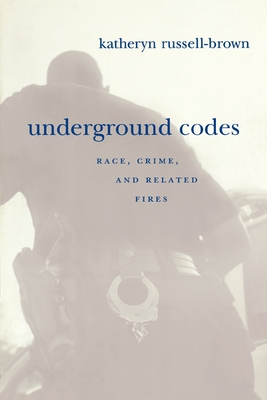 Underground Codes: Race, Crime, and Related Fires
Underground Codes: Race, Crime, and Related Fires
by Katheryn Russell-BrownNew York University Press (Feb 01, 2004)
Read Detailed Book Description
Winner of a 2005 Gustavus Myers Outstanding Book Award (Honorable Mention
Americans fear crime, are rattled by race, and avoid honest discussions of both. Anxiety, denial, miscommunication, and ignorance abound. Imaginary connections between minorities and crime become real, self-fulfilling prophecies and authentic links to race, class, gender and crime go unexplored. Katheryn Russell-Brown, the author of the highly acclaimed The Color of Crime, makes her way through this intellectual minefield, determined to shed light on the most persistent and perplexing domestic policy issues.
The author tackles a range of race and crime issues. From outdated research methods that perpetuate stereotypes about African Americans, women, and crime to the overhyped discourse about gangsta rap and lawbreaking, Russell-Brown challenges the conventional wisdom of criminology. Underground Codes delves into understudied topics such as victimization rates for Native Americans—among the highest of any racial group—and how racial profiling affects the day-to-day lives of people of color.
Innovative, well-researched and meticulously documented, Underground Codes makes a case for greater public involvement in the debate over law enforcement—and our own language—that must be heard if we are to begin to have a productive national conversation about crime and race.
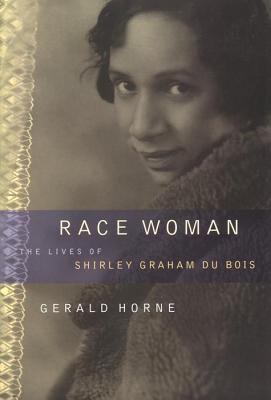 Race Woman: The Lives of Shirley Graham Du Bois
Race Woman: The Lives of Shirley Graham Du Bois
by Gerald HorneNew York University Press (Feb 15, 2002)
Read Detailed Book Description
One of the most intriguing activists and artists of the twentieth century, Shirley Graham Du Bois also remains one of the least studied and understood. In Race Woman, Gerald Horne draws a revealing portrait of this controvertial figure who championed the civil rights movement in America, the liberation struggles in Africa and the socialist struggles in Maoist China. Through careful analysis and use of personal correspondence, interviews, and previously unexamined documents, Horne explores her work as a Harlem Renaissance playwright, biographer, composer, teacher, novelist, Left political activist, advisor and inspiration, who was a powerful historical actor.
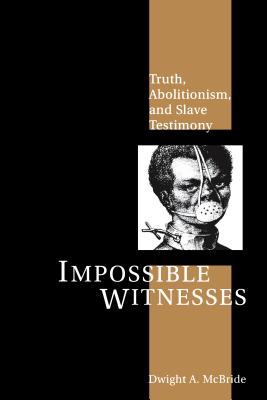 Impossible Witnesses: Truth, Abolitionism, and Slave Testimony
Impossible Witnesses: Truth, Abolitionism, and Slave Testimony
by Dwight McBrideNew York University Press (Dec 01, 2001)
Read Detailed Book Description
Even the most cursory review of black literary production during the nineteenth century indicates that its primary concerns were the issues of slavery, racial subjugation, abolitionist politics and liberation. How did the writers of these narratives "bear witness" to the experiences they describe? At a time when a hegemonic discourse on these subjects already existed, what did it mean to "tell the truth" about slavery? Impossible Witnesses explores these questions through a study of fiction, poetry, essays, and slave narratives from the abolitionist era. Linking the racialized discourses of slavery and Romanticism, it boldly calls for a reconfiguration of U.S. and British Romanticism that places slavery at its center. Impossible Witnesses addresses some of the major literary figures and representations of slavery in light of discourses on natural rights and law, offers an account of Foucauldian discourse analysis as it applies to the problem of "bearing witness," and analyzes specific narratives such as "Narrative of the Life of Frederick Douglass," and "The Interesting Narrative of the Life of Olaudah Equiano." A work of great depth and originality, Impossible Witnesses renders traditional interpretations of Romanticism impossible and places Dwight A. McBride at the forefront of studies in race and literature.
 In The Company Of Black Men: The African Influence On African American Culture In New York City
In The Company Of Black Men: The African Influence On African American Culture In New York City
by Craig WilderNew York University Press (Nov 01, 2001)
Read Detailed Book Description
From the subaltern assemblies of the enslaved in colonial New York City to the benevolent New York African Society of the early national era to the formation of the African Blood Brotherhood in twentieth century Harlem, voluntary associations have been a fixture of African-American communities. In the Company of Black Men examines New York City over three centuries to show that enslaved Africans provided the institutional foundation upon which African-American religious, political, and social culture could flourish. Arguing that the universality of the voluntary tradition in African-American communities has its basis in collectivism—a behavioral and rhetorical tendency to privilege the group over the individual—it explores the institutions that arose as enslaved Africans exploited the potential for group action and mass resistance. Craig Steven Wilder’s research is particularly exciting in its assertion that Africans entered the Americas equipped with intellectual traditions and sociological models that facilitated a communitarian response to oppression. Presenting a dramatic shift from previous work which has viewed African-American male associations as derivative and imitative of white male counterparts, In the Company of Black Men provides a ground-breaking template for investigating antebellum black institutions.
 Sisters in the Struggle: African American Women in the Civil Rights-Black Power Movement
Sisters in the Struggle: African American Women in the Civil Rights-Black Power Movement
by Bettye Collier-ThomasNew York University Press (Aug 01, 2001)
Read Detailed Book Description
The rarely heard stories of the brave women at the forefront of the Civil Rights Movement
Women were at the forefront of the civil rights struggle, but their individual stories were rarely heard. Only recently have historians begun to recognize the central role women played in the battle for racial equality.
In Sisters in the Struggle, we hear about the unsung heroes of the civil rights movements such as Ella Baker, who helped found the Student Non-Violent Coordinating Committee, Fannie Lou Hamer, a sharecropper who took on segregation in the Democratic Party (and won), and Septima Clark, who created a network of “Citizenship Schools” to teach poor Black men and women to read and write and help them to register to vote. We learn of Black women’s activism in the Black Panther Party where they fought the police, as well as the entrenched male leadership, and the Southern Christian Leadership Conference, where the behind-the-scenes work of women kept the organization afloat when it was under siege. It also includes first-person testimonials from the women who made headlines with their courageous resistance to segregation—Rosa Parks, Charlayne Hunter-Gault, and Dorothy Height.
This collection represents the coming of age of African-American women’s history and presents new stories that point the way to future study.
Contributors: Bettye Collier-Thomas, Vicki Crawford, Cynthia Griggs Fleming, V. P. Franklin, Charlayne Hunter-Gault, Farah Jasmine Griffin, Duchess Harris, Sharon Harley, Dorothy I. Height, Chana Kai Lee, Tracye Matthews, Genna Rae McNeil, Rosa Parks, Barbara Ransby, Jacqueline A. Rouse, Elaine Moore Smith, and Linda Faye Williams.
 Black Gay Man: Essays
Black Gay Man: Essays
by Robert F. Reid-PharrNew York University Press (Apr 01, 2001)
Read Detailed Book Description
The landmark book that established Robert Reid-Pharr as one of America’s most exciting and challenging left intellectuals
At turns autobiographical, political, literary, erotic, and humorous, Black Gay Man spoils our preconceived notions of not only what it means to be Black, gay, and male but also what it means to be a contemporary intellectual. Both a celebration of Black gay male identity as well as a powerful critique of the structures that allow for the production of that identity, Black Gay Man introduced the eloquent voice of Robert Reid-Pharr in cultural criticism.
At once erudite and readable, the range of topics and positions taken up in Black Gay Man reflect the complexity of American life itself. Treating subjects as diverse as the Million Man March, interracial sex, anti-Semitism, turn-of-the-century American intellectualism, as well as literary and cultural figures ranging from Essex Hemphill and Audre Lorde to W.E.B. Du Bois, Frantz Fanon, and James Baldwin, Black Gay Man is a bold and nuanced attempt to question prevailing ideas about community, desire, politics, and culture. Moving beyond critique, Reid-Pharr also pronounces upon the promises of a new America.
 Within The Veil: Black Journalists, White Media
Within The Veil: Black Journalists, White Media
by Pamela NewkirkNew York University Press (Jul 01, 2000)
Read Detailed Book Description
Winner of the National Press Club Prize for Media Criticism. Companion website: http://www.nyupress.nyu.edu/authors/veil.html Thirty years ago, the Kerner Commission Report made national headlines by exposing the consistently biased coverage afforded African Americans in the mainstream media. While the report acted as a much ballyhooed wake-up call, the problems it identified have stubbornly persisted, despite the infusion of black and other racial minority journalists into the newsroom. In Within the Veil, Pamela Newkirk unmasks the ways in which race continues to influence reportage, both overtly and covertly. Newkirk charts a series of race-related conflicts at news organizations across the country, illustrating how African American journalists have influenced and been denied influence to the content, presentation, and very nature of news. Through anecdotes culled from interviews with over 100 broadcast and print journalists, Newkirk exposes the trials and triumphs of African American journalists as they struggle in pursuit of more equitable coverage of racial minorities. She illuminates the agonizing dilemmas they face when writing stories critical of blacks, stories which force them to choose between journalistic integrity, their own advancement, and the almost certain enmity of the black community. Within the Veil is a gripping front-line report on the continuing battle to integrate America’s newsrooms and news coverage.
 African American Literary Theory: A Reader
African American Literary Theory: A Reader
by Winston NapierNew York University Press (Jun 30, 2000)
Read Detailed Book Description
African American Literary Theory: A Reader is the first volume to document the central texts and arguments in African American literary theory from the 1920s through the present. As the volume progresses chronologically from the rise of a black aesthetic criticism, through the Blacks Arts Movement, feminism, structuralism and poststructuralism, and the rise of queer theory, it focuses on the key arguments, themes, and debates in each period.By constantly bringing attention to the larger political and cultural issues at stake in the interpretation of literary texts, the critics gathered here have contributed mightily to the prominence and popularity of African American literature in this country and abroad. African American Literary Theory provides a unique historical analysis of how these thinkers have shaped literary theory, and literature at large, and will be a indispensable text for the study of African American intellectual culture.Contributors include Sandra Adell, Michael Awkward, Houston A. Baker, Jr., Hazel V. Carby, Barbara Christian, W.E.B. DuBois, Ann duCille, Ralph Ellison, Henry Louis Gates, Jr., Addison Gayle Jr., Carolyn F. Gerald, Evelynn Hammonds, Phillip Brian Harper, Mae Gwendolyn Henderson, Stephen E. Henderson, Karla F.C. Holloway, Langston Hughes, Zora Neale Hurston, LeRoi Jones (Amiri Baraka), Joyce A. Joyce, Alain Locke, Wahneema Lubiano, Deborah E. McDowell, Harryette Mullen, Larry Neal, Charles I. Nero, Robert F. Reid-Pharr, Marlon B. Ross, George S. Schuyler, Barbara Smith, Valerie Smith, Hortense J. Spillers, Sherley Anne Williams, and Richard Wright.
